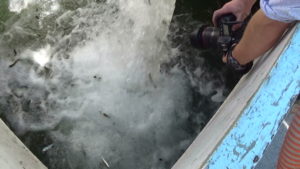
Transporting baby salmon in tanks with circulating water mounted on boats or barges can eliminate the river and Delta losses of the fish released at the hatcheries in low water years while allowing the fish to imprint as they move downriver. Imprinting minimizes straying when they return as adults.
Commercial salmon fishermen along with the California Department of Fish and Wildlife did a multi-year study to evaluate the barging of salmon smolts from two hatcheries to the Golden Gate. Feather River hatchery and Mokelumne River hatchery fish were used. Survival and straying of Feather River barged fish wasn’t very different from similar fish that were trucked and net pen acclimated prior to release. However, the Mokelumne hatchery fish survived at higher rates, as measured by return of adult fish to the hatchery, and straying was very low.
Success in this program could open a significant new method of producing and handling hatchery fish while avoiding the high predator Delta losses and potentially reducing straying.
The next problem to address is how to scale up transport of fish using barges since millions typically need to be moved. Finding long term, secure financing is another problem to be solved.
